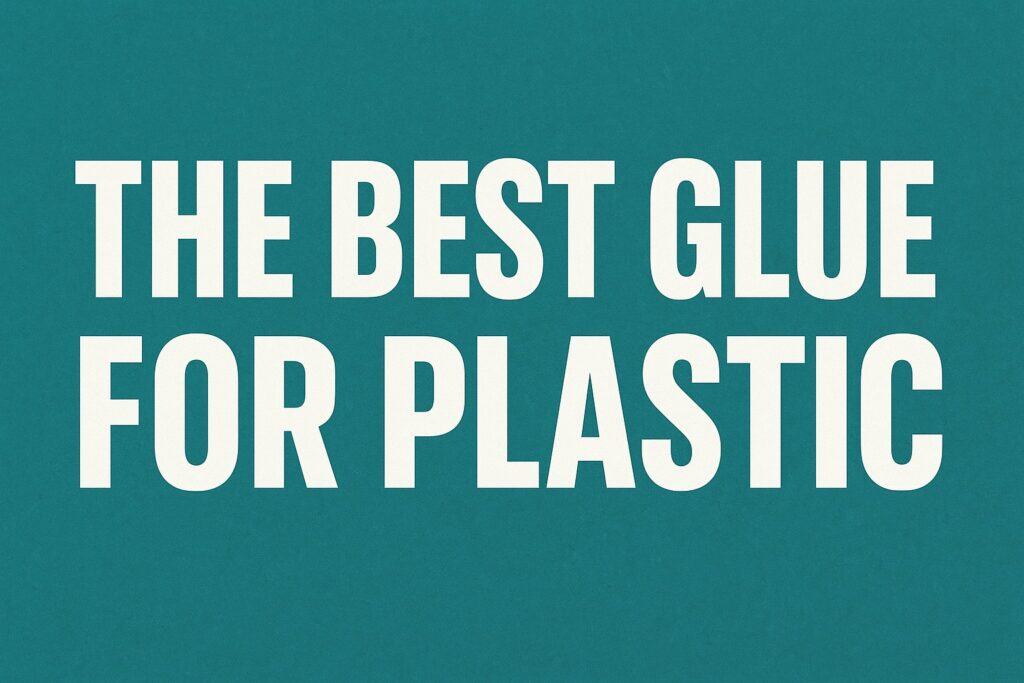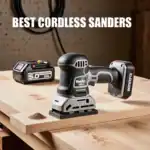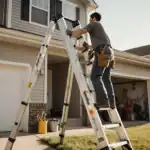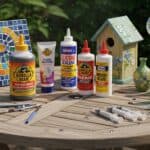Have you ever felt that sinking feeling as a treasured plastic item snaps in your hands? Whether it’s a child’s action figure, a vital kitchen appliance, or a cracked car part, the frustration is universal. The challenge is that most common household glues fail on plastic. This is because many plastics have a slick, low-energy surface that actively resists adhesion, making repairs difficult.
This guide is here to help you get stuck the right way. We will explore the science behind why plastic is so tricky to bond, break down the main types of adhesives available, and review the best glues for any plastic repair job you might face. By matching the right adhesive chemistry to the specific plastic and application, you can turn a break into an unbreakable bond.
Quick Comparison Table of Top Picks
| Product | Best For | Type | Dry Time |
|---|---|---|---|
| Gorilla Super Glue Gel | Overall Use & Impact Resistance | Super Glue (Cyanoacrylate) | 10-45 seconds |
| J-B Weld Plastic Bonder | Heavy-Duty Structural Repairs | Epoxy | Sets in 15 minutes |
| Loctite Plastics Bonding System | Difficult Plastics (PE & PP) | Specialty Adhesive (CA + Primer) | Sets in seconds |
| Loctite Vinyl, Fabric & Plastic | Flexible Plastic & Vinyl | Flexible Adhesive | 24 hours to cure |
| Krazy Glue All Purpose | Quick, Budget-Friendly Fixes | Super Glue (Cyanoacrylate) | Sets in seconds |

Why Plastic Is So Hard to Glue
The main reason plastic is so difficult to glue comes down to a property called surface energy. Plastics can be divided into two main categories based on this property:
- High Surface Energy (HSE) Plastics: Materials like ABS, acrylic, and polycarbonate are relatively easy to glue. Their surfaces allow adhesives to spread out and “wet” the material, which helps form a strong chemical bond.
- Low Surface Energy (LSE) Plastics: This group is the real challenge. It includes common materials like polyethylene (PE) and polypropylene (PP), as well as Teflon (PTFE). These plastics have non-stick, non-porous surfaces that resist bonding.
To successfully bond these tricky LSE plastics, you often need either a specialized adhesive designed to “bite” into the surface or a surface treatment like a primer to make the material more receptive to the glue.
The Main Types of Glues for Plastic
Choosing the right glue depends entirely on the type of plastic you’re working with and the kind of repair you need to make.
- Super Glue (Cyanoacrylate): Known for creating a fast, hard bond. Perfect for quick, small-scale repairs on rigid plastics like PVC and ABS. Standard formulas are often brittle.
- Epoxy: A two-part system (resin and hardener) that creates an incredibly strong, durable, and rigid bond. It is the best choice for structural repairs and for filling gaps.
- Plastic Weld / Solvent Cement: This adhesive chemically melts the surface of the plastic, fusing the pieces into one solid part. It is plastic-specific (e.g., for ABS or acrylic) and creates a permanent weld.
- Specialty Plastic Adhesives: For the toughest jobs—bonding low-energy plastics like PE and PP—you need a specialty system. These typically involve a primer to treat the surface, followed by a powerful adhesive.
The Best Glues for Plastic in 2025: Product Reviews
Best Overall (Super Glue Gel): Gorilla Super Glue Gel
Gorilla Super Glue Gel stands out because it solves many of the problems of traditional liquid super glues.
Why it wins: Its thicker, no-run gel formula gives you more control, which is especially useful for vertical applications. Crucially, it is formulated with rubber particles, which provide added impact resistance and flexibility, resulting in a bond that is far more durable than brittle standard super glues.
- Pros: The gel formula prevents drips, it offers enhanced impact resistance, and it’s versatile.
- Cons: Like other super glues, it is not the best choice for filling large gaps.
No products found.
Best for Heavy-Duty Repairs (Epoxy): J-B Weld Plastic Bonder
When a repair needs to be permanent and structural, a two-part epoxy like J-B Weld is a top choice.
Why it wins: J-B Weld’s Plastic Bonder is designed to create incredibly strong, permanent bonds that can fill cracks and gaps. Once cured, the bond is so tough it can be sanded, drilled, and painted, treating it like the original material.
- Pros: It offers tremendous bond strength, excels at filling gaps, and is sandable and paintable.
- Cons: It requires mixing and has a longer clamp and cure time measured in minutes and hours, not seconds.
- J-B Weld Clearweld: A Clear, Quick Setting And Multipurpose Two Part Epoxy That Provides A Strong And Lasting Bond On Surfaces Including Metal, Tile, Most Plastics, Ceramic, Glass, Wood And More. J-B Weld Clearweld Comes In A Syringe Allowing For An Easy 1:1 Mix Ratio. The Unique Syringe Has A Re-Sealable Cap That Prevents Drying Out And Leaking, Allowing For Multiple Uses
- Cure And Set Time: After Mixing The Two Part Formula With The Included Mixing Tray And Stir Stick, Clearweld Takes 5 Minutes To Set And 1 Hour To Cure. J-B Weld Clearweld Set And Cure Color Is Clear
- Strength: J-B Weld Clearweld Has Tensile Strength Of 3900 Psi
- Surface Applications: Metal, Most Plastics, Pvc, Wood, Concrete, Ceramic & Tile, Fiberglass And Glass
Best for Difficult Plastics (PP & PE): Loctite Plastics Bonding System
This product is a game-changer for plastics that are notoriously resistant to glue.
Why it wins: This is a two-step system that revolutionizes how we bond difficult plastics. It comes with a primer that treats the surface of low-energy plastics like polyethylene (PE) and polypropylene (PP). After applying the primer, the included super glue can form a powerful, quick bond that would otherwise be impossible.
- Pros: It works on virtually all plastics, acts fast, and has a precision nozzle.
- Cons: The two-step application process is slightly more work, and it is not a gap-filling adhesive.
- Advanced Bonding System: Two-part adhesive formula includes glue and activator to prime surfaces for a superior bond
- Fuses Hard-to-bond Plastics: Easily bonds to plastics such as polyethylene (PE), polypropylene (PP), and Polytetrafluoroethylene (PTFE)
- Tremendous Strength: Highly-resistant, strong cyanoacrylate adhesive with no required clamping or mixing
- Sets In Seconds: Bonding system instantly dries transparent for invisible repairs
- Weatherproof: Resistant to water, most chemicals, and freezing temperatures
Best for Flexible Plastic: Loctite Vinyl, Fabric & Plastic Flexible Adhesive
Rigid bonds aren’t always what you need. For items that need to bend and flex, this adhesive is the perfect solution.
Why it wins: It is specifically designed to create a bond that remains flexible after it dries. This makes it ideal for repairing items like vinyl upholstery, inflatables, and other flexible plastic products that need to move without cracking the repair.
- Pros: It dries clear, stays flexible, and is waterproof.
- Cons: It doesn’t provide the same structural strength as an epoxy, so it’s not suited for rigid, load-bearing repairs.
- Mends Rips and Tears: Liquid adhesive formulated for repairing and mending flexible plastics like vinyl seats, cushions, tarps, and outdoor gear
- Flexible and Versatile: Highly flexible adhesive withstands bending and torsion for long-lasting repairs on seats, clothing, shoes, rainwear, fabric, canvas, rubber, and leather
- Invisible Repairs: Adhesive dries clear and transparent and will not yellow or go brittle with age or sunlight for long-lasting repairs
- Fast and Easy: High-speed adhesive sets in just 10 minutes and cures fully in 24 hours
- Waterproof: Waterproof and resilient bond for repairing raincoats, wading pools, beach balls, and more
Best Budget Option: Krazy Glue All Purpose
For quick, simple fixes around the house, this classic adhesive is a reliable and affordable choice.
Why it wins: It’s a household name for a reason. For small repairs on common, easy-to-glue plastics (but not PE or PP), it is fast, inexpensive, and effective.
- Pros: It’s very affordable, widely available, and bonds in seconds.
- Cons: The bond is brittle, offering little to no impact resistance, and it doesn’t work on all types of plastic.
No products found.
Pro Tips for Gluing Plastic Successfully
To ensure the strongest possible bond, preparation is key. Following these steps will dramatically improve your results:
- Clean the Surface: Use isopropyl alcohol or soap and water to thoroughly clean the plastic surfaces. This removes any dirt, oils, or grease that can prevent the glue from adhering properly.
- Roughen the Surface: For smooth plastics, lightly sanding the bonding area with fine-grit sandpaper (120-200 grit) makes a huge difference. This creates a rougher texture that the glue can “grip.”
- Ensure a Snug Fit: Before applying any glue, make sure the broken pieces fit together perfectly.
- Use Clamps: Applying firm, consistent pressure while the adhesive cures is crucial for achieving maximum bond strength. Clamp the pieces together and leave them undisturbed for the full recommended curing time.
- Ventilate Your Workspace: Many adhesives release strong fumes, so it’s important to work in a well-ventilated area.
Frequently Asked Questions (FAQs)
- Q. What is the strongest type of glue for plastic?
A. For structural repairs requiring maximum strength, a two-part epoxy is generally the strongest option. They form incredibly rigid, high-strength bonds that are also great for filling gaps. - Q. Can I use hot glue on plastic?
A. Hot glue can be used for temporary, non-structural bonds, but it will peel off most plastics quite easily and should not be relied upon for a durable repair. - Q. Does Gorilla Glue work on all plastics?
A. While many Gorilla Glue products are effective on plastic, the original polyurethane formula is not recommended for use on polypropylene (PP) or polyethylene (PE) plastics. Specific products, like Gorilla Super Glue Gel, are more effective on a wider range of plastics. - Q. How do I remove super glue from plastic or my hands?
A. For plastic, carefully use acetone (nail polish remover), but test it on a hidden area first, as it can damage some plastics. For hands, soak the area in warm, soapy water to slowly dissolve the bond, or use acetone and wash thoroughly afterward.
Final Thoughts
The key takeaway is that there is no single “best” glue for all plastics. Success lies in matching the adhesive to the specific type of plastic and the demands of the repair. For general household use, Gorilla Super Glue Gel offers a great balance of speed and durability. For heavy-duty repairs, an epoxy like J-B Weld Plastic Bonder is unbeatable. And for those frustratingly slick plastics, the Loctite Plastics Bonding System is the specialized tool that gets the job done. With the right adhesive and proper preparation, your next plastic repair can be stronger than the original material.











1 thought on “The Best Glue for Plastic: Top Picks for Every Repair”